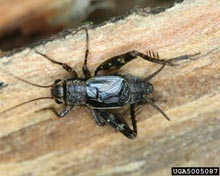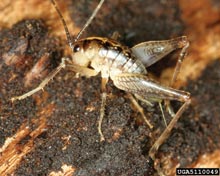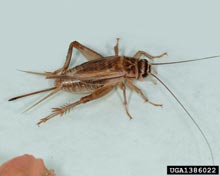
David Cappaert , Michigan State University

David Cappaert , Michigan State University

Joseph Berger
Crickets
General Description
The chirping cricket is music to some ears (especially those of female crickets), but annoying to others. Crickets
hide in cracks and voids in the ground, around foundations, in woodpiles, under rocks and debris, and become
active at night to chirp (males only) and to feed on a variety of foods including plants, fruits, vegetables, and other
Crickets.
Commonly found indoors, the house cricket (Acheta domesticus) is tan in color and is up to an inch long. Capable of living and reproducing indoors, house crickets are often found in the warmest parts of the house. They will consume human and pet foods, are attracted to fermenting liquids (vinegar, beer, etc.), are common around trash dumps, and occasionally do incidental damage to fabrics. They are attracted to lights at night. Field crickets (Gryllus spp.) are larger than house crickets (up to 1 1/4 inches) and are black. They do not reproduce indoors and are most often encountered around foundations, in sheds, garages and gardens. They will damage garden plants, crops and fabrics.
General Control
Most house and field cricket home invasions occur in fall when the insects’ food resources dry up and
temperatures drop. Seal foundation cracks and gaps, and install door brushes to prevent crickets from entering
gaps beneath doors. Other controls include reducing vegetation, leaves and mulch around the structure and, in
early fall, treating foundation perimeters with residual pesticide liquids or cricket baits.









